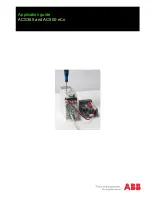
21
TK-290
7. Control Circuit
The control unit consists of microprocessor IC406, flash
memory IC414, and its peripheral circuits. It controls the TX-
RX unit and transfers data to and from the control unit. The
CPU (IC406) mainly performs the following :
1) Switching between transmission and reception by PTT
signal input.
2) Reading channel, frequency, and program data from the
memory circuit.
3) Sending frequency program data to the PLL.
4) Controlling squelch on/off by the pulse signal input from
the squelch circuit.
5) Controlling the audio mute circuit by decode data input.
6) Transmitting encode data (QT, DQT).
7) Sending serial data to output expander (IC400, IC403,
IC404 and IC405) to control various function in the unit.
7-1. Memory circuit
IC414 is a flash memory with a capacity of 2M bits that
contains the transceiver control program for the CPU and
data such as transceiver channels and operating features.
This program can be easily written from an external de-
vices. Data, such as DTMF memories and operating status,
are programmed into the EEPROM (IC412).
IC406
CPU
IC412
IC414
EEPROM
IC415
ADDRESS
DECODE
FLASH
ROM
Fig. 12
Memory circuit
7-2. CPU clock shift
When the CPU (IC406) 12MHz clock (X400) high fre-
quency is multiplexed with the reception frequency, it be-
comes an internal beat signal, suppressing the signal sensi-
tivity. To prevent this, by turning Q407 on, the clock fre-
quency is shifted (about 4kHz).
(Shift on/off can be set through programming.)
8
IC406
CPU
X1
X2
Vcc
11
10
12
C448
Q407
SW
R428
R487
C444
C447
DGND
C449
R459
X400
12MHz
Fig. 13
CPU clock frequency shift
Fig. 14
Key input
7-3. Shift register
IC400, 403, 404 and 405 is an interface IC for output port
expansion. It is used to expand the CPU (IC406) output
ports.
7-4. D/A converter
IC3 and IC603 is used as a conventional semi-fixed-resis-
tor converter. It sets the following :
1) RX sensitivity
2) Transmission power
3) Modulation level
4) Audio power
5) Frequency
7-5. Key input
KI1 or KI2 becomes HIGH when any key is pressed (or
Enable signal on the optional circuit).
When KI1 or KI2 becomes HIGH, KI0 also becomes HIGH
to trigger the interrupt to IC406 in order to start the key
scan.
When the key scan starts, the output terminals (Q1~Q5)
become LOW. Only the key sensing circuit remains HIGH.
When a key is pressed, the signal is routed through KI1 or
KI2 to the microprocessor. Then, the microprocessor deter-
mines which key is pressed using this signals.
CIRCUIT DESCRIPTION
IC2
Q1 Q2 Q3 Q4 Q5
IC406
CPU
Monitor
SW A
SW B
IC4
TC7SH08
FU
Tone1
Tone2
OPPTT
TCONT
CLK,DAT,STB
OPPTT
TCONT
MAND
KEY1
KEY2
















































